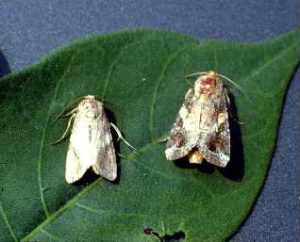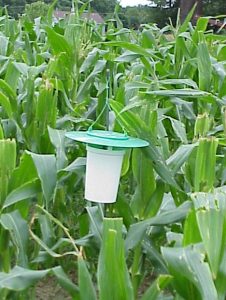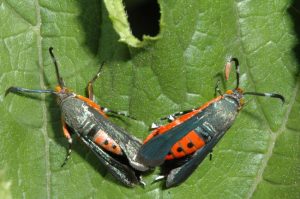Sweet Corn IPM Newsletter No. 2 – July 19, 2019
Sweet Corn IPM Newsletter No. 2 – July 19, 2019
Click on photos to enlarge.
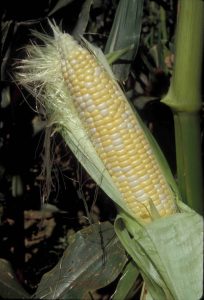
FALL ARMYWORM, CORN EARWORM THREATEN EARLY CORN
Fields Silking Now Require Protection
Highmoor Farm Field Day
For Fruit and Vegetable Growers
Monmouth, Maine
Wednesday, July 31 from 2:30 p.m. to 7:30 p.m.
Preregister now!
SITUATION
Warmer weather has advanced corn development rapidly in much of the state. Earliest planted corn in southern Maine is mostly in silk. Fall armyworm has arrived just in time to threaten early silking corn, in addition to corn earworm, and European corn borer. While the greatest threat is presently to silking corn, both European corn borer and fall armyworm can cause significant injury to younger corn stages as well. Warm temperatures predicted for the days ahead will likely increase insect activity, so growers with silking corn should consider protecting it.
European corn borer: Feeding injury was over the 15% control threshold for pre-tassel corn in Biddeford, one Cape Elizabeth site, one Dayton site, Oxford, Poland Spring, and Sabattus. Sprays during the pre-tassel stage, when both moths and larvae are present, can control larvae before they move into the protection of the stalks and ears. Once corn reaches the silk stage, sprays may be based on the number of moths caught in pheromone traps. Moths will lay eggs on flag leaves of silking corn, and the larvae can move into the ears without leaving visible feeding injury. If more than five moths are caught during a week in silking corn, a spray is recommended. European corn borer moth counts were over the spray threshold for silking corn this week in Sabattus, but this field was also on a recommended spray interval for corn earworm, which should also provide protection against corn borer.
- European Corn Borer Larvae on Pre-tassel Stage Corn; photo by David Handley
- Corn Earworm Moth; photo by David Handley
Corn earworm: We are finding earworm moths at more locations throughout the state this week, and more fields with silking corn that are susceptible to infestation. A six-day spray interval for silking corn was recommended in Auburn, one Cape Elizabeth site, one Dayton Site, North Berwick, and Sabattus. A five-day spray interval was recommended for a silking field in Nobleboro.
- Fall Armyworm Moths (female right, male left); photo by James Dill
- Fall Armyworm Pheromone Trap, photo by David Handley
Fall armyworm: The first moths were caught in pheromone traps this week, creating a threat to silking corn. A small amount of larval feeding damage was also noticed on pre-tassel corn, suggesting that this will become a more widespread problem soon. Sprays to protect silking corn against fall armyworm were recommended in Biddeford, Farmington, New Gloucester, and Wayne. These sites were not under a spray interval for corn earworm yet, so a spray specifically for fall armyworm is warranted.
Squash vine borer moths were caught in pheromone traps in Wells, Biddeford and Oxford this week. Counts were above the spray threshold of 5 moths in Biddeford and Oxford, suggesting that this pest is now a significant threat to squash and pumpkins. Squash vine borer moths are black and orange and resemble wasps. They lay their eggs at the base of squash plants. The larvae bore into the base of the plants, causing vines to wilt and collapse. Growers with squash should be on the lookout for vine borer symptoms and protect plants if moths or damage are seen. See the 2018-2019 New England Vegetable Management Guide for control options.
- Two Squash Vine Borer Moths; photo by Jeffrey Hahn, Univ. of Minnesota Extension
- Potato Leafhopper; photo by James Dill
Potato leafhopper alert: potato leafhopper is now active in vegetable and berry fields. These small, bullet-shaped insects feed on plant sap from the undersides of leaves, causing the leaves to become curled, stunted and yellow-streaked. Beans are often the first crop to show symptoms, but other crops are also susceptible, including potatoes, peppers, eggplant, strawberries and raspberries. To scout for leafhoppers, brush the leaves of the plants with your hand. The small, whitish adults can be seen flying off the plant. Look for small, light green leafhopper nymphs on the underside of injured leaves. They are about 1/16-inch long. When touched, they will crawl sideways in a crab-like manner. Control options for potato leafhoppers are listed in the New England Vegetable Management Guide.
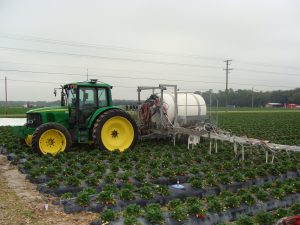
Sprayer Calibration
Nick Rowley, Research Associate in Vegetable Production, Highmoor Farm
A leading cause for inaccurate pesticide application is variability between individual nozzles on the sprayer. While the sprayer might be putting out the targeted rate, the application could be inconsistent between nozzles or sides, causing over or under pesticide coverage. All nozzles wear out over time, and this happens faster when spraying abrasive materials or using water with fine sediment.
Nozzle variability considerations:
- Test individual nozzles to check for variability.
- Replace or clean nozzles that differ from their rated output by roughly +/- 5%.
- Think about replacing old nozzles with new ones made from a more durable material when spraying abrasive products; however, these tend to be more costly.
- Consider filtering mixing water with higher levels of sediment.
…Generally replacing worn nozzles pays for itself within the first season.
Sprayer calibration links:
A short article about nozzle variability from The Western Producer: Sprayer calibration saves money and environment
A quick video showing how to check nozzles using a measuring cup on a boom sprayer from Gempler’s : How to Analyze Spray Tip Output and Pattern (Shows how to calculate acceptable variation at 1:30.)

University of Maine Highmoor Farm Field Day
Wednesday, July 31, 2019, 2:30 PM to 7:30 PM
Highmoor Farm, Monmouth, Maine
Registration fee is $30.00 (includes dinner)
The field day will include tours of current research projects in tree fruit and in vegetables and berries. Growers are welcome to attend the whole event, or may come for just the afternoon tours or evening program. Whichever you decide, please plan to be there for dinner to share some time and informal discussion with fellow farmers, research and Extension staff and state officials.
Preregistration is strongly encouraged. Register online or contact Pam St. Peter at pamela.stpeter@maine.edu or 207.933.2100 for registration information. (Registration is closed)
If you need a reasonable accommodation, please contact Pam St. Peter at 207.933.2100 by July 17, 2019. If requests are received after this date, we may not have sufficient time to make necessary arrangements; however, all requests will be considered.
Sincerely,
David T. Handley
Vegetable and Small Fruit Specialist
Highmoor Farm UMaine Extension Diagnostic
P.O. Box 179 Research Lab, Pest Mgmt. Unit
52 U.S. Route 202 17 Godfrey Drive
Monmouth, ME 04259 Orono, ME 04473
207.933.2100 1.800.287.0279
Sweet Corn IPM Weekly Scouting Summary
| Location | CEW Moths |
ECB Moths |
FAW Moths |
%Feeding Damage |
Recommendations / Comments |
|---|---|---|---|---|---|
| Auburn | 3 | 3 | 0 | 5% | 6-day spray interval for all silking corn |
| Biddeford | 0 | 0 | 3 | 33% | One spray for FAW on silking corn, ECB on pre-tassel |
| Bowdoinham | 0 | 3 | 0 | 3% | No spray recommended |
| Cape Elizabeth I | 0 | 1 | 0 | 5% | No spray recommended |
| Cape Elizabeth II | 2 | 0 | 0 | 15% | 6-day spray interval for silking corn, ECB on pre-tassel |
| Dayton I | 0 | 1 | 0 | No spray recommended | |
| Dayton II | 3 | 0 | 0 | 15% | 6-day spray interval for silking corn, ECB on pre-tassel |
| Farmington | 1 | 0 | 17 | 1% | One spray for FAW on silking corn |
| Lewiston | 0 | 4 | 0 | 1% | No spray recommended |
| New Gloucester | 0 | 2 | 8 | 1% | One spray for FAW on silking corn |
| Nobleboro | 5 | 0 | 0 | 0% | 5-day spray interval for all silking corn |
| No. Berwick | 2 | 0 | 0 | 6% | 6-day spray interval for all silking corn |
| Oxford | 0 | 0 | 0 | 20% | One spray for ECB on pre-tassel corn |
| Poland Spring | 0 | 18% | One spray for ECB on pre-tassel corn | ||
| Sabattus | 3 | 5 | 0 | 15% | 6-day spray interval for all silking corn |
| Wayne | 0 | 3 | 3 | 6% | One spray for FAW on silking corn |
| Wells I | 0 | 0 | 0 | 5% | No spray recommended |
| Wells II | 0 | 0 | 0 | 3% | No spray recommended |
CEW: Corn earworm (Only fresh silking corn should be sprayed for this insect.)
ECB: European corn borer
FAW: Fall armyworm
Corn Earworm Spray Thresholds for Pheromone Traps
| Moths caught per week | Moths caught per night | Spray interval |
|---|---|---|
| 0.0 to 1.4 | 0.0 to 0.2 | No spray |
| 1.5 to 3.5 | 0.3 to 0.5 | Spray every 6 days |
| 3.6 to 7.0 | 0.6 to 1.0 | Spray every 5 days |
| 7.1 to 91 | 1.1 to 13.0 | Spray every 4 days |
| More than 91 | More than 13 | Spray every 3 days |
Thresholds apply only to corn with exposed fresh silk. Lengthen spray intervals by one day if maximum daily temperature is less than 80°F.
European Corn Borer Thresholds
Whorl stage: 30% or more of plants scouted show injury.
Pre-tassel-silk: 15% or more of plants scouted show injury.
Silk: 5 or more moths caught in pheromone traps in one week.
IPM Web Pages:
UMaine Cooperative Extension Integrated Pest Management
Penn State Pest Watch – Sweet Corn
UMass Amherst Integrated Pest Management
Where brand names or company names are used, it is for the reader’s information. No endorsement is implied nor is any discrimination intended against other products with similar ingredients. Always consult product labels for rates, application instructions and safety precautions. Users of these products assume all associated risks.
The University of Maine is an equal opportunity/affirmative action institution.



